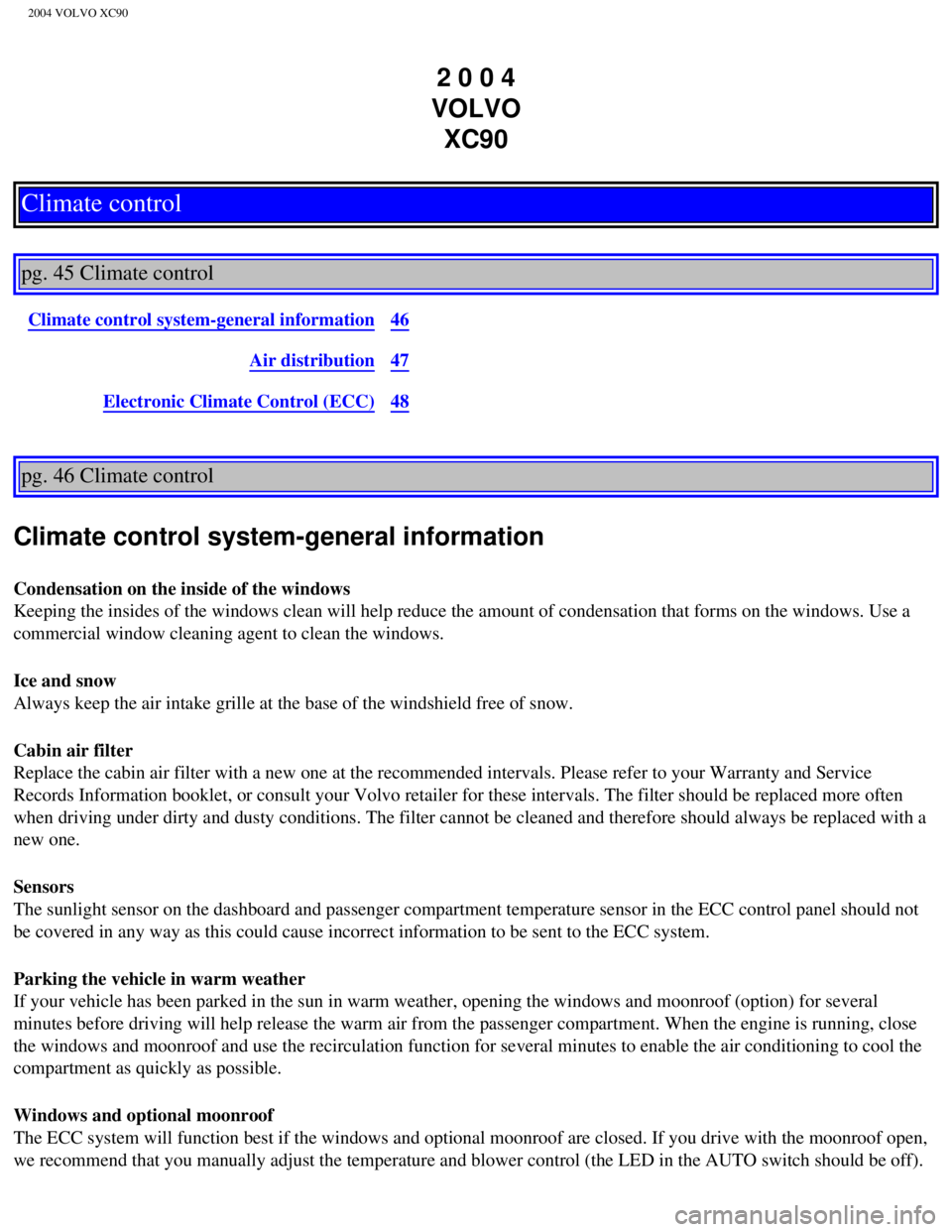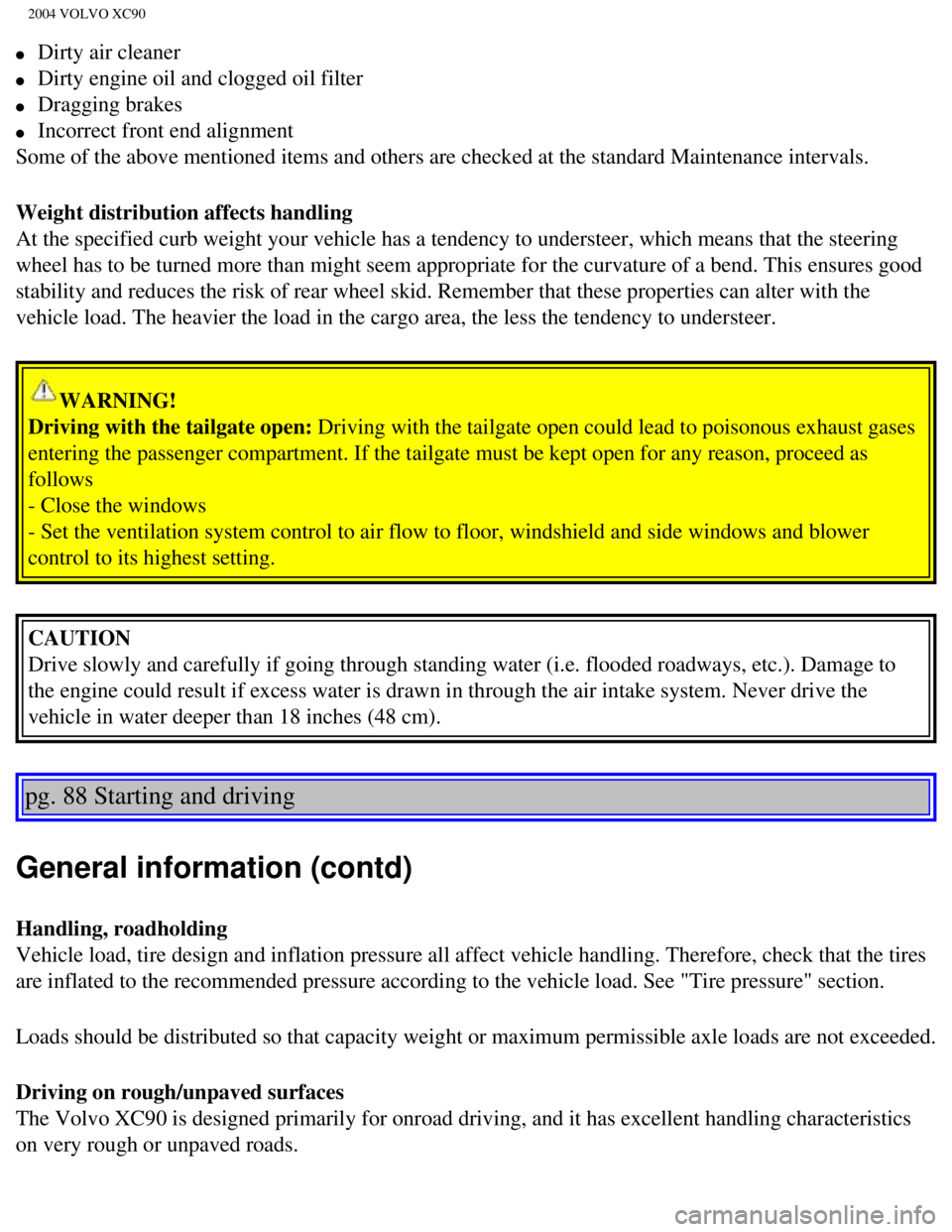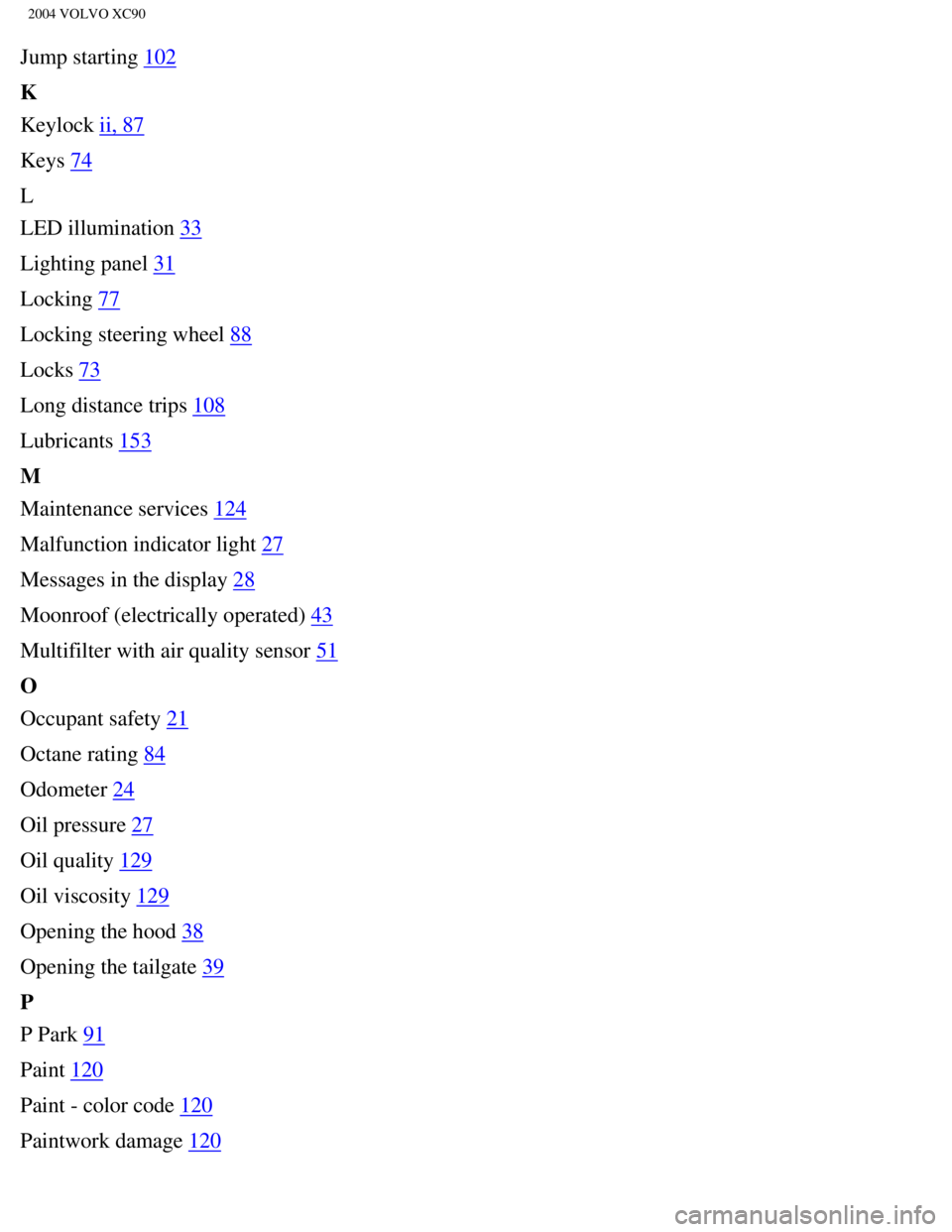2004 VOLVO XC90 air filter
[x] Cancel search: air filterPage 68 of 245

2004 VOLVO XC90
2 0 0 4
VOLVO XC90
Climate control
pg. 45 Climate control
Climate control system-general information46
Air distribution47
Electronic Climate Control (ECC)48
pg. 46 Climate control
Climate control system-general information
Condensation on the inside of the windows
Keeping the insides of the windows clean will help reduce the amount of \
condensation that forms on the windows. Use a
commercial window cleaning agent to clean the windows.
Ice and snow
Always keep the air intake grille at the base of the windshield free of \
snow.
Cabin air filter
Replace the cabin air filter with a new one at the recommended intervals\
. Please refer to your Warranty and Service
Records Information booklet, or consult your Volvo retailer for these in\
tervals. The filter should be replaced more often
when driving under dirty and dusty conditions. The filter cannot be clea\
ned and therefore should always be replaced with a
new one.
Sensors
The sunlight sensor on the dashboard and passenger compartment temperatu\
re sensor in the ECC control panel should not
be covered in any way as this could cause incorrect information to be se\
nt to the ECC system.
Parking the vehicle in warm weather
If your vehicle has been parked in the sun in warm weather, opening the \
windows and moonroof (option) for several
minutes before driving will help release the warm air from the passenger\
compartment. When the engine is running, close
the windows and moonroof and use the recirculation function for several \
minutes to enable the air conditioning to cool the
compartment as quickly as possible.
Windows and optional moonroof
The ECC system will function best if the windows and optional moonroof a\
re closed. If you drive with the moonroof open,
we recommend that you manually adjust the temperature and blower control\
(the LED in the AUTO switch should be off).
file:///K|/ownersdocs/2004/2004_XC90/04xc90_03.htm (1 of 7)12/30/2006 \
4:35:16 PM
Page 73 of 245

2004 VOLVO XC90
A/C - ON/OFF
Press the switch to turn the air conditioning on or off. The "ON" or "OF\
F" LED will light up to indicate if the system is
switched on or off. Other functions will still be regulated automaticall\
y (if the AUTO switch is on).
l The air conditioning functions only at temperatures above 32° F (0°\
C).
l While the Defroster function is selected, the air conditioning is tempor\
arily activated to dehumidify the air, even if you
have manually switched the air conditioning off. This will only function\
if the blower is not switched off.
Recirculation
Press this switch to engage the recirculation function (air in the pass\
enger compartment recirculates - no fresh air enters the
compartment). The LED in the switch will light up to indicate that the \
function is engaged.
l Use this function if the outside air is contaminated with exhaust gases,\
smoke, etc or to heat/cool the vehicle quickly.
l Recirculation should not be used for more than 15 minutes. If your windows begin to fog or mist, make sure that the
recirculation function is switched off.
l Selecting Defroster automatically switches recirculation off.
l Timer mode activation: (Vehicles equipped with the Interior Air Quality System have no timer m\
ode) Press and hold
the recirculation button for at least 3 seconds to activate a recirculat\
ion timer mode. The amber LED in the recirculation
button will flash 5 times to show that the timer mode is being activated\
. In timer mode, each time the recirculation button is
pressed, the climate control system will recirculate the air in the pass\
enger compartment for 5-12 minutes, depending on the
outside air temperature, and then revert back to fresh air.
l Timer mode deactivation: Press and hold the recirculation button for 3 s\
econds. The amber LED in the recirculation
button will illuminate steadily for 5 seconds to show a return to "norma\
l" mode.
pg. 51 Climate control
l In normal mode, when the recirculation button is pressed, the climate co\
ntrol system will recirculate the air in the
passenger compartment until the recirculation button is pressed again.
l Timer mode memory: If the vehicle is turned off while timer mode is acti\
ve, timer mode will still be active when the
vehicle is restarted.
Interior Air Quality sensor (option)
Some vehicles are equipped with a multifilter and Air Quality sensor. Th\
e filter separates gases and particles, thereby
reducing the amounts of odors and contaminants entering the vehicle. The\
Air Quality sensor detects increased levels of
contaminants in the outside air. When the Air Quality sensor detects con\
taminated outside air, the air intake closes and the
air inside the passenger compartment is recirculated, i.e. no outside ai\
r enters the vehicle. The filter also cleans recirculated
passenger compartment air. When the ECC system is in the AUTO mode, the \
green LED will be on
.
file:///K|/ownersdocs/2004/2004_XC90/04xc90_03.htm (6 of 7)12/30/2006 \
4:35:16 PM
Page 74 of 245

2004 VOLVO XC90
Operation
Press
to operate the Air Quality sensor (normal setting).
Or:
Select one of the following three functions by pressing
1, 2 or 3 times.
1. The AUT LED lights. The Air Quality sensor is now activated.
2. No LED lights. Recirculation is not activated unless needed to cool t\
he passenger compartment in a warm climate.
3. The MAN LED lights. Recirculation is now activated.
Keep in mind the following:
l Make it a rule to have the Air Quality sensor activated at all times.
l Recirculation is limited in cold climates to avoid fogging.
l If window fogging occurs, you should deactivate the Air Quality sensor. \
l If fogging occurs, use the defroster functions for the windshield, side \
windows and rear window. See page 49.
l The filter should be changed at the intervals recommended in the mainten\
ance schedule. However, if the vehicle is used
in a severely contaminated environment, it may be necessary to change th\
e filter more frequently.
pg. 52 Climate control
This page intentionally left blank
Contents | Top of Page
file:///K|/ownersdocs/2004/2004_XC90/04xc90_03.htm (7 of 7)12/30/2006 \
4:35:16 PM
Page 115 of 245

2004 VOLVO XC90
l Dirty air cleaner
l Dirty engine oil and clogged oil filter
l Dragging brakes
l Incorrect front end alignment
Some of the above mentioned items and others are checked at the standard\
Maintenance intervals.
Weight distribution affects handling
At the specified curb weight your vehicle has a tendency to understeer, \
which means that the steering
wheel has to be turned more than might seem appropriate for the curvatur\
e of a bend. This ensures good
stability and reduces the risk of rear wheel skid. Remember that these p\
roperties can alter with the
vehicle load. The heavier the load in the cargo area, the less the tende\
ncy to understeer.
WARNING!
Driving with the tailgate open: Driving with the tailgate open could lead to poisonous exhaust gases
entering the passenger compartment. If the tailgate must be kept open fo\
r any reason, proceed as
follows
- Close the windows
- Set the ventilation system control to air flow to floor, windshield an\
d side windows and blower
control to its highest setting.
CAUTION
Drive slowly and carefully if going through standing water (i.e. floode\
d roadways, etc.). Damage to
the engine could result if excess water is drawn in through the air inta\
ke system. Never drive the
vehicle in water deeper than 18 inches (48 cm).
pg. 88 Starting and driving
General information (contd)
Handling, roadholding
Vehicle load, tire design and inflation pressure all affect vehicle hand\
ling. Therefore, check that the tires
are inflated to the recommended pressure according to the vehicle load. \
See "Tire pressure" section.
Loads should be distributed so that capacity weight or maximum permissib\
le axle loads are not exceeded.
Driving on rough/unpaved surfaces
The Volvo XC90 is designed primarily for onroad driving, and it has exce\
llent handling characteristics
on very rough or unpaved roads.
file:///K|/ownersdocs/2004/2004_XC90/04xc90_06a.htm (9 of 15)12/30/200\
6 4:35:22 PM
Page 159 of 245

2004 VOLVO XC90
Information booklet provides a comprehensive periodic maintenance schedu\
le up to 150,000 miles
(240,000 km) of vehicle maintenance. The schedule includes components \
that affect vehicle emissions.
This page describes some of the emission-related components.
Engine air filter
The engine air filter cleans particles from air entering the engine. Rep\
lace the engine air filter cartridge
with a new one every 37,500 miles (60,000 km) under normal driving con\
ditions. Replace the cartridge
more often when the vehicle is driven under dirty and dusty conditions. \
The cartridge cannot be cleaned,
and should always be replaced with a new one.
Fuel filter
The fuel filter should be replaced at 120,000 miles (193,000 km). The \
filter is replaced as a complete
unit. Replace more frequently if contaminated fuel is introduced into th\
e tank, or if there is reason to
suspect that this has occurred.
Fuel system, including filler cap, tank, lines, and connections
The ability of the fuel system to contain hydrocarbons depends upon a le\
ak-free system. Inspect fuel
lines every 30,000 miles (48,000 km). Check for proper sealing of the \
fuel filler cap, which contains "O"
ring seals.
NOTE: If the fuel filler cap is not closed tightly or if the engine is running\
when the vehicle is refueled,
the Check Engine light (Malfunction Indicator) may indicate a fault. H\
owever, your vehicle's
performance will not be affected. Use only Volvo original or approved fu\
el filler caps.
Timing belt
For proper functioning of the engine and emission control systems, the t\
iming belt and belt pretensioner
must be replaced every 120,000 miles (193,000 km). Engine damage will \
occur if the belt fails.
PCV system
(on turbocharged models)
The nipple in the intake manifold and the filter at the end of the PCV h\
ose in the air cleaner should be
inspected and cleaned at 120,000 miles (193,000 km), and again at 150,\
000 miles (240,000 km).
Spark plugs
The spark plugs should be replaced every 60,000 miles (96,000 km) unde\
r normal driving conditions.
City driving or fast highway driving may necessitate replacement sooner.\
Under normal driving conditions, spark plugs require no maintenance betw\
een replacement intervals.
When installing new plugs, be sure to use the right type and to tighten \
them correctly. When changing
the plugs, clean the terminals and rubber seals. Also check that the sup\
pressor connectors are in good
condition. Cracked or damaged connectors should be replaced.
file:///K|/ownersdocs/2004/2004_XC90/04xc90_09a.htm (3 of 14)12/30/200\
6 4:35:26 PM
Page 238 of 245

2004 VOLVO XC90
Jump starting 102
K
Keylock
ii, 87
Keys
74
L
LED illumination
33
Lighting panel
31
Locking
77
Locking steering wheel
88
Locks
73
Long distance trips
108
Lubricants
153
M
Maintenance services
124
Malfunction indicator light
27
Messages in the display
28
Moonroof (electrically operated)
43
Multifilter with air quality sensor
51
O
Occupant safety
21
Octane rating
84
Odometer
24
Oil pressure
27
Oil quality
129
Oil viscosity
129
Opening the hood
38
Opening the tailgate
39
P
P Park
91
Paint
120
Paint - color code
120
Paintwork damage
120
file:///K|/ownersdocs/2004/2004_XC90/04xc90_12.htm (6 of 13)12/30/2006\
4:35:33 PM